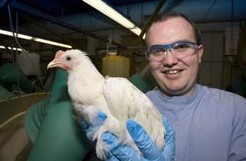Developing a new non-invasive test for welfare status
Published: August 9, 2012
By: Poultry CRC
New Poultry CRC research is aimed at developing a non-invasive test to assess welfare status in birds. The project is led by joint project leaders Drs Tamsyn Crowley and Anthony Keyburn, from Poultry CRC participants, Deakin University and CSIRO, respectively. Anthony and Tamsyn plan to use cutting-edge genetic technology to create a new test, which will exploit the properties of small non-coding ribonucleic acids (RNAs), called microRNAs or ‘miRNA’.

Anthony explains that, “traditionally, stress in birds is assessed by measuring the amount of the hormone corticosterone in blood, which works because corticosterone is released by the adrenal glands when the bird’s body prepares for ‘flight’ or ‘fight’.”
Whilst corticosterone level is an important indicator of stress and is the basis for a valuable non-invasive test, it has its drawbacks. Corticosterone is released in response to a wide variety of stressors, including changes in temperature, humidity, housing space, feed and water. Despite a great deal of refinement and improvement for the test, it is still difficult to pinpoint the precise cause of stress by measuring corticosterone level alone. As Tamsyn concludes, “even the very act of taking a blood sample from a bird can dramatically affect corticosterone levels in less than a minute.”
“Finding non-invasive tests for health, production and welfare of farm animals has been a top priority for research and the advent of genomics and molecular biology technology will help advance this important research area”, says Mingan Choct, CEO of Poultry CRC. Indeed, Anthony and Tamsyn are going to work with a number of established animal welfare researchers, combining traditional approaches and frontier science to search for additional objective measures of poultry welfare. Their idea is to use miRNA profiling as a definitive measure of a bird’s welfare status based on leads in other research findings. As Tamsyn notes, “recent studies investigating diseases in humans and other animals have shown clear differences in the expression patterns of miRNAs in the blood from healthy animals compared to those suffering disease.” Anthony added, “since miRNAs are found in human and cow milk, it’s reasonable to expect to find them in eggs. Therefore Tamsyn and I should be able to develop a technique to assess welfare status using eggs, and possibly excreta, non-invasively.”
There are a number of existing behavioural and other tests (such as blood and egg cortisone levels) that provide insight into the welfare of poultry. However, if this project is successful, it will provide a clear cut and non-invasive scientific test to determine the welfare status or stress levels of birds, especially laying hens, in various production systems.
Source
Poultry CRCRelated topics:
Recommend
Comment
Share

11 de agosto de 2012
Stress in poultry is either not understood at all or understood wrongly by most post people who are in the business. Few people appreciate the dynamics of STRESS and it's far reaching consequences. Sadly,many have taken stress to be a normal and unavoidable dimension of poultry farming. Congratulations, Doctors, and our best wishes to the two of you for your up coming efforts in discovering this non invasive test which I am sure will go a long way in relating stress and welfare to performance. Leo Antony
Recommend
Reply

Would you like to discuss another topic? Create a new post to engage with experts in the community.
